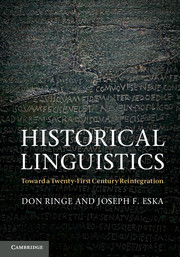Book contents
- Frontmatter
- Contents
- Figures
- Tables
- Preface
- Acknowledgments
- Introduction
- 1 The nature of human language and language variation
- 2 Language replication and language change
- 3 Language change in the speech community
- 4 Language contact as a source of change
- 5 Sound change
- 6 The evolution of phonological rules
- 7 Morphology
- 8 Morphological change
- 9 Syntactic change
- 10 Reconstruction
- 11 Beyond comparative reconstruction
- Appendix: Recovering the pronunciation of dead languages: types of evidence
- References
- General index
- Index of languages and families
5 - Sound change
Published online by Cambridge University Press: 05 February 2013
- Frontmatter
- Contents
- Figures
- Tables
- Preface
- Acknowledgments
- Introduction
- 1 The nature of human language and language variation
- 2 Language replication and language change
- 3 Language change in the speech community
- 4 Language contact as a source of change
- 5 Sound change
- 6 The evolution of phonological rules
- 7 Morphology
- 8 Morphological change
- 9 Syntactic change
- 10 Reconstruction
- 11 Beyond comparative reconstruction
- Appendix: Recovering the pronunciation of dead languages: types of evidence
- References
- General index
- Index of languages and families
Summary
Spontaneous changes in pronunciation – for which “sound change” is, unexpectedly, the technical term – are the best understood type of language change. In this chapter we discuss the basic facts of sound change, the motivation of sound changes in phonetic terms, and their effects on a language's phonological system; in the following chapter we will discuss the evolution of the phonological rules into which some sound changes develop.
The trajectory of sound changes and the regularity of sound change
Every sound change must begin as an acquisition error which survives and is copied (see Chapter 2). Since the beginnings of that process are practically impossible to observe, we must infer the sources of those errors. At least the following are probable sources of new sound changes (see Ohala 1993, 2003 for amplification and much further discussion).
The child simply fails to learn a meaningful contrast between two sounds, so that a merger of the sounds results. The widespread North American English merger of /ɑ/ and /ɔ/ mentioned in Chapter 3, and the merger of /ər/ and /ɔr/ in a child's speech mentioned in Chapter 2, are typical examples. Merger can of course result from each of the other types of error (b) through (d) listed below; we list failure to learn a contrast separately because it seems possible that in some circumstances such a failure is not motivated by any of the other factors listed.
The child misinterprets recurrent performance errors as the outputs of a variable phonological rule, which is therefore learned. This is a probable scenario because the sound changes which are attested in the historical record overlap significantly with typical performance errors. Long-range metathesis, the transposition of two sounds not adjacent in the stream of speech (as in Spanish milagro ‘miracle’ ← medieval Latin mīrāculum), is an obvious candidate for this scenario; so is haplology, dropping one of two syllables that begin with the same onset (as in North American English prob'ly for probably; see further Chapter 6). But sound changes of other kinds might also begin this way (see Browman and Goldstein 1991: 324–5).
Because certain articulatory gestures or (more often) sequences of gestures require unusually great effort and/or precise timing, the child fails to learn to produce them, or to produce them consistently. A large proportion of sound changes could arise this way.
…
- Type
- Chapter
- Information
- Historical LinguisticsToward a Twenty-First Century Reintegration, pp. 78 - 104Publisher: Cambridge University PressPrint publication year: 2013



